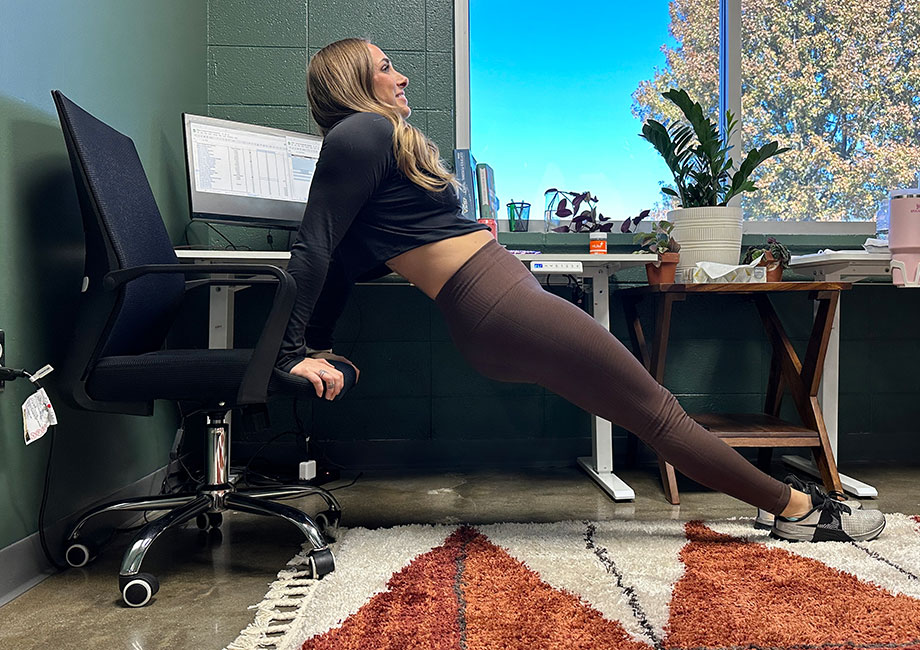We test and review fitness products based on an independent, multi-point methodology. If you use our links to purchase something, we may earn a commission. Read our disclosures.
Work has become increasingly sedentary over the years. The U.S. Bureau of Labor Statistics1 reports that the average American civilian worker spends a staggering 43.6% of the workday sitting down. To make matters worse, studies show2 that prolonged sitting poses various health risks to your physical and mental health, ultimately resulting in early mortality3 in many cases.
The 9-to-5 grind isn’t always glamorous; it’s a necessary means to an end, so what can we do to promote our good health when our jobs have us bound to a desk and chair for hours?
“Get in an office workout,” says Kate Meier, NASM-CPT, USAW-L1, CF-L1, and GGR Head of Content. “It might sound facetious, but working in a few office stretches and exercises while at work can be very beneficial for your overall health and well-being.”
RELATED: At-Work Stretches
We’re covering the best desk exercises and stretches you can squeeze into your workday, as well as benefits of office exercises, tips on how to break up periods of prolonged sitting, and even a sample office workout. Check it out below!
Desk/Chair Exercises
Trying to get in some reps at your desk? Try these on for size!
Desk (or Chair) Push-Up
Why we love it: Push-ups are one of the best bodyweight exercises, and because they require no equipment, they’re portable, too! Using your desk reduces the range of motion, activating your chest, shoulders, and triceps without forcing you to sweat into your professional dress.
How to do it:
- Stand up and move your chair out of the way.
- Place your hands shoulder-width apart on your desk and step your feet back.
- Slowly lower your chest towards your desk until it lightly touches.
- Push yourself back to the starting position.
RELATED: What Muscles Do Push-Ups Work?
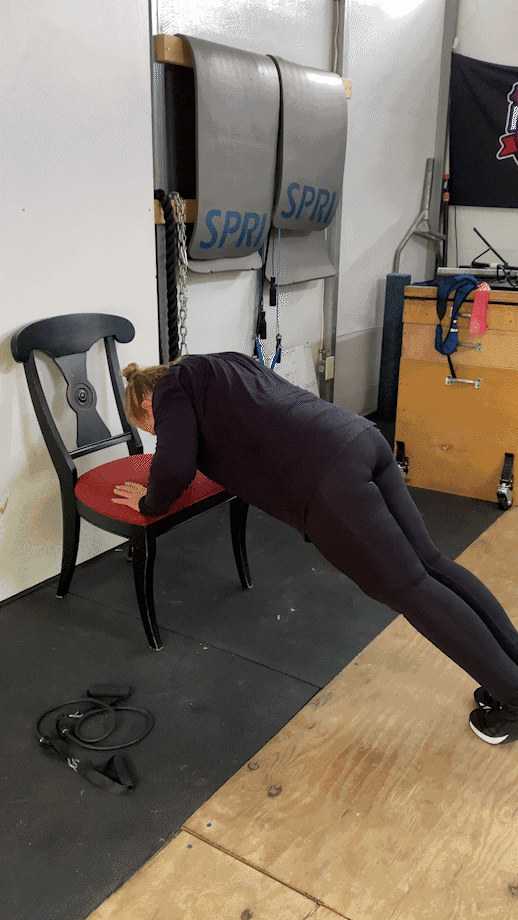
Chair Dip
Why we love it: Triceps dips are another handy bodyweight exercise you can do just about anywhere. Just be careful if your office chair has wheels; you don’t want to go flying!
How to do it:
- Stand up and roll your chair away from the desk so you have room.
- With your back to the chair, place your palms on the seat and step your feet away, keeping them planted on the floor for safety.
- Slowly lower your body by bending your elbows.
- Continue until your elbows form 90-degree angles.
- Pause, then push yourself back up.
RELATED: At-Home Bodyweight Workout
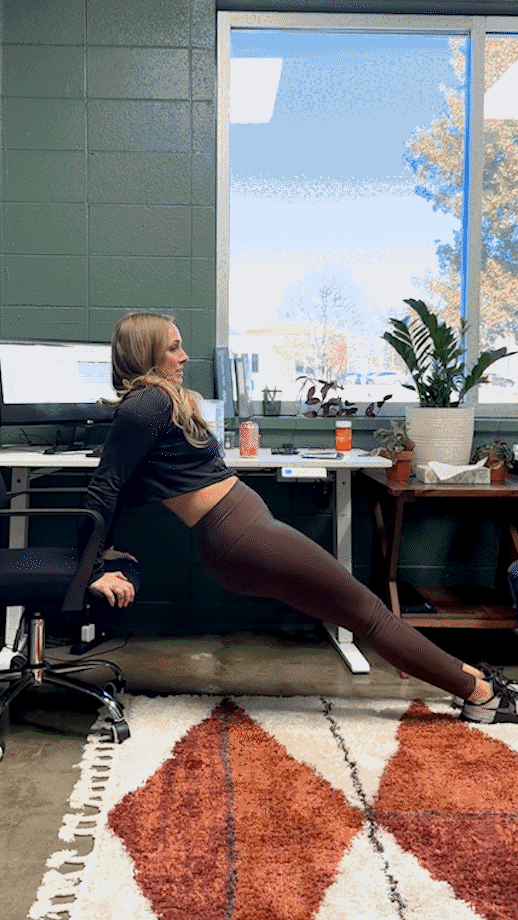
Chair Squat
Why we love it: “Using a chair is useful for learning proper squat depth,” says Kate Meier, CPT, USAW-L1, CF-L1, “so adding chair squats to your desk workout is a great way to open your hips, target lower body muscles and get your blood flowing for that next round of emails you need to work through.”
How to do it:
- Stand in front of your chair with your feet shoulder-width apart and back straight.
- Tighten your core, shift your hips back, and bend your knees like you’re going to sit.
- Lightly touch the chair seat, then push through your heels to stand back up.
RELATED: What Muscles Do Squats Work?
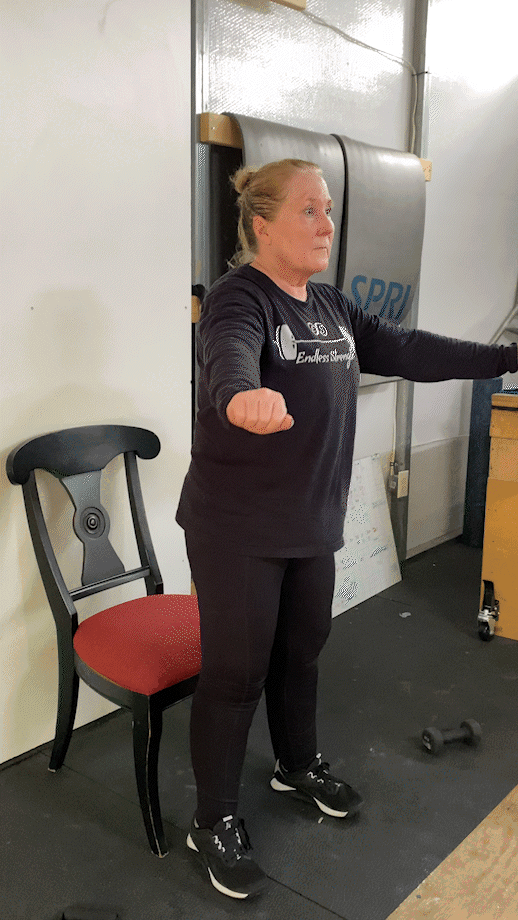
Seated Calf Raise
Why we love it: The calves are often overlooked when it comes to lower body muscles, but they play a crucial role in stabilizing the ankle during sports as well as regular walking. So, why not try making calf exercises a part of your office workout routine?
How to do it:
- Sit forward in your chair, keeping both feet planted on the floor.
- Push into the floor with your toes, raising your heels.
- Slowly bring your feet back down.
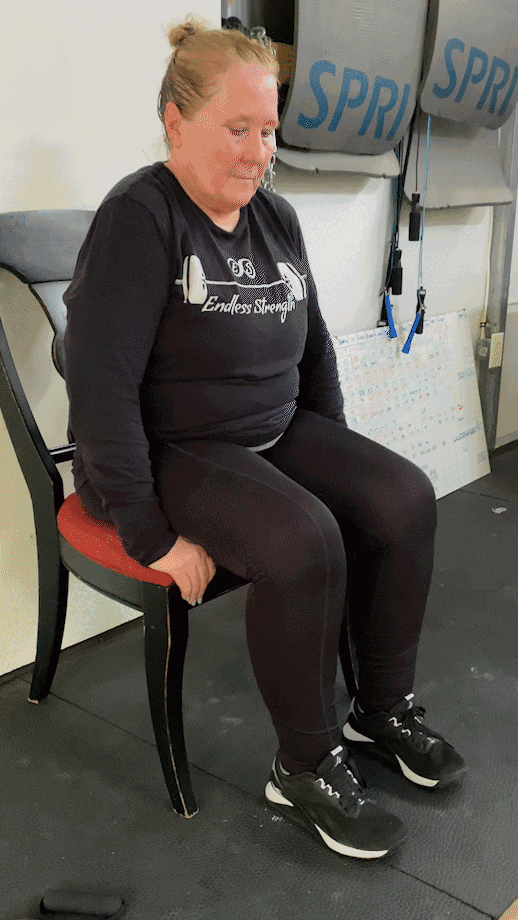
Desk (or Chair) Plank
Why we love it: Sedentary lifestyles contribute to weakened core muscles and chronic low back pain; however, a study in the Journal of Physical Therapy Science4 shows that core strength training using exercises like the plank improves core stability, promotes good posture, and helps alleviate pain in the lower back.
How to do it:
- Stand up and move your chair so you have room.
- Place your hands or forearms on the desk depending on if you want to hold a high plank or forearm plank. Step back your feet so your body creates a straight line.
- Hold the position for the desired duration.
RELATED: Plank Exercise Variations
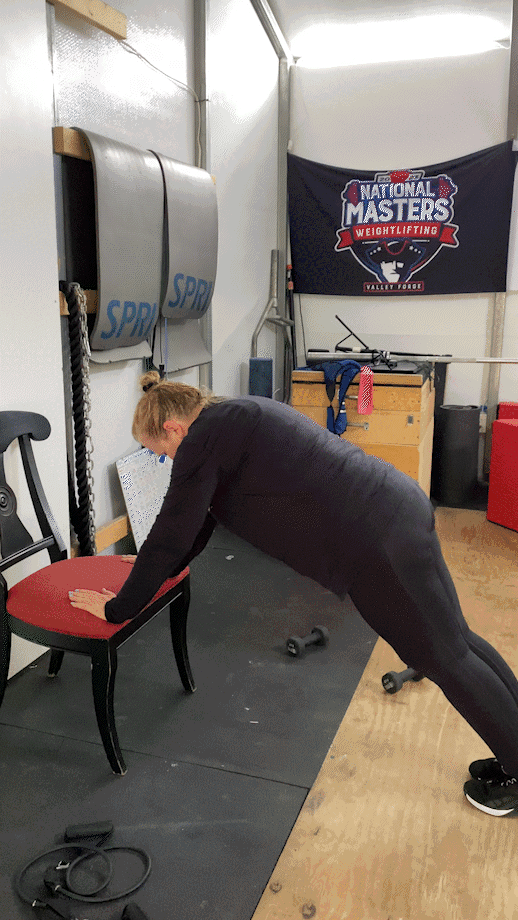
Standing Exercises
What’s the best way to break up prolonged periods of sitting? Standing up, of course! Here are a few movements you can do after getting out of your chair.
Side Lunge
Why we love it: Side lunges target muscles like the quadriceps, glutes, and hamstrings, but the lateral movement also encourages a contraction from your hip abductors, helping improve hip mobility and flexibility. That should feel great after you’ve been sitting awhile!
How to do it:
- Stand with your feet approximately hip-width apart, take a big step to your left.
- Shift your weight into your left knee, allowing your right leg to straighten.
- Push into the left foot, stepping back to center.
- Repeat the movement now using your right foot to lead.
- Alternate sides on each rep until the set is complete.
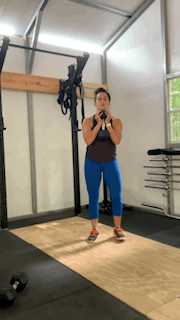
Single-Leg Deadlift
Why we love it: “Single-leg deadlifts provide great muscle activation in your hamstrings,” says Kate, “which will feel amazing after keeping your legs bent while stuck at your desk all day. They’re great for improving balance and coordination as well.”
How to do it:
- Place the item you’re going to deadlift on the floor in front of you. You may choose to keep a light dumbbell or kettlebell in the office for this, but you can use a work bag, heavy work binder, or other substitute if needed.
- Lift one foot off the floor, then hinge forward at the hips to reach down and grab your dumbbell, keeping your back straight, lifted leg straight, and a slight bend in the front leg.
- Grip the dumbbell, then drive into your planted heel to stand back up.
- Repeat as needed, then switch sides and repeat the set.
RELATED: Unilateral Exercises
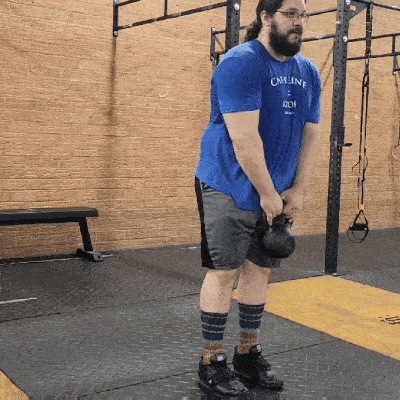
Jumping Jacks
Why we love it: Jumping jacks are the quintessential warm-up calisthenic exercise. They’re guaranteed to get your heart rate up, helping you improve your cardio fitness and burn calories.
How to do it:
- Stand with your arms at your sides and your feet shoulder-width apart.
- Jump both feet out to the sides, lifting both arms overhead simultaneously.
- Jump back to the starting position.
- Repeat for the desired duration or number of reps.
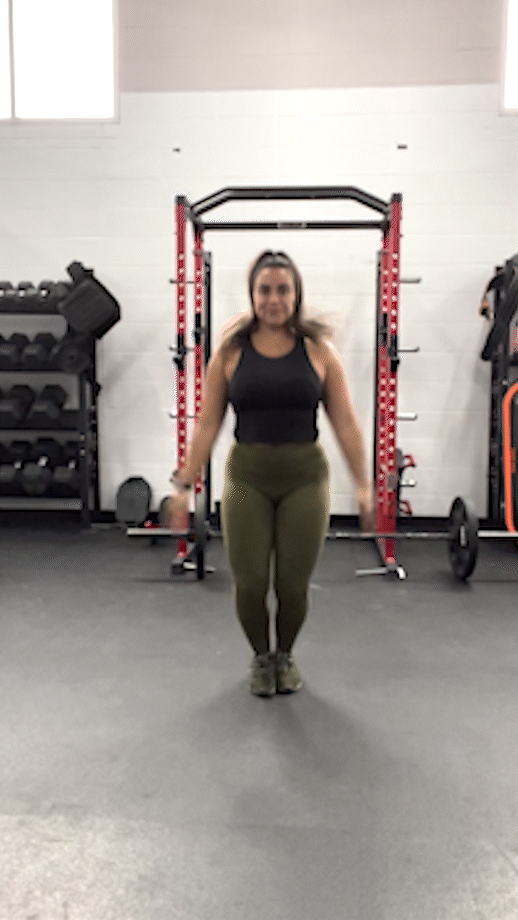
High Knees
Why we love it: High knees are an excellent agility exercise that also spikes your heart rate, burning calories and contributing to weight loss efforts. They’re especially good for your hip flexors, which are commonly sore in office workers since staying seated leaves them compressed all day.
How to do it:
- Stand with your feet hip-width apart, arms out in front, chest up, and back straight.
- Bring your left knee up until it taps your left hand, then bring it down.
- Repeat for your right knee.
- Continue alternating sides until you complete the desired duration or number of reps.
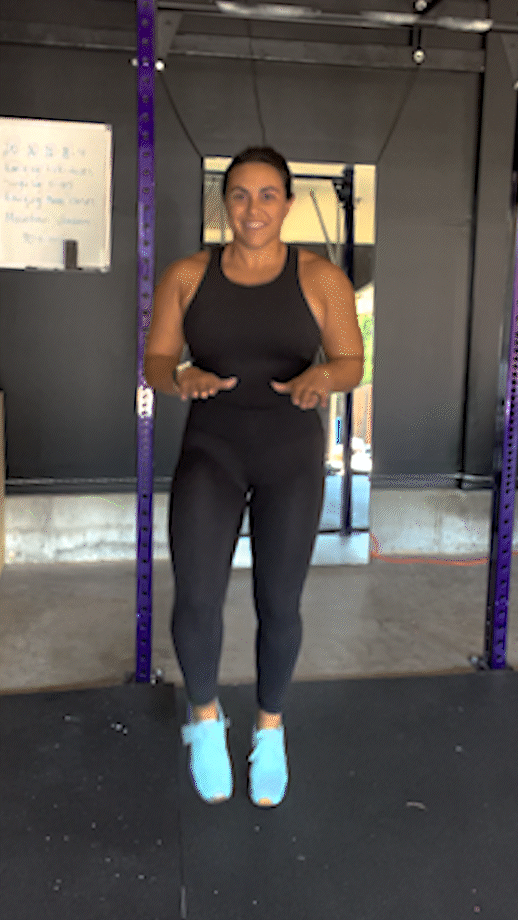
Wall Sit
Why we love it: The wall sit exercise is an isometric exercise that works lower body muscles, improves core stability, and enhances muscular endurance. Holding the position also helps build mental toughness, which you’ll need in spades to survive the stress of a high pressure office job!
How to do it:
- Lean against a wall, touching with your upper back, lower back, and back of your head.
- Slide down, as though sitting, until your thighs are nearly parallel to the floor.
- Hold the position for the desired duration, then release and rest.
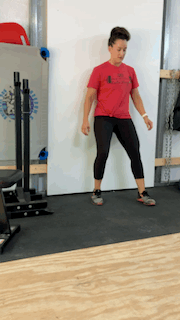
Stretches
Sitting in the same position for hours wreaks havoc on your poor muscles. Work some of the following stretches into your workday to keep loose and limber while getting your work done.
Triceps Stretch
Why we love it: The triceps tend to get tight when you’re typing away at a keyboard all day. Loosening them up with an overhead triceps stretch helps improve circulation, flexibility, and range of motion.
How to do it:
- Roll your shoulders back, raise your right arm, and bend the right elbow so your right hand winds up behind your back and neck.
- Reach up and place your left hand on the right elbow.
- Lightly push down to deepen the stretch.
- Hold for the desired duration, then switch sides and repeat.
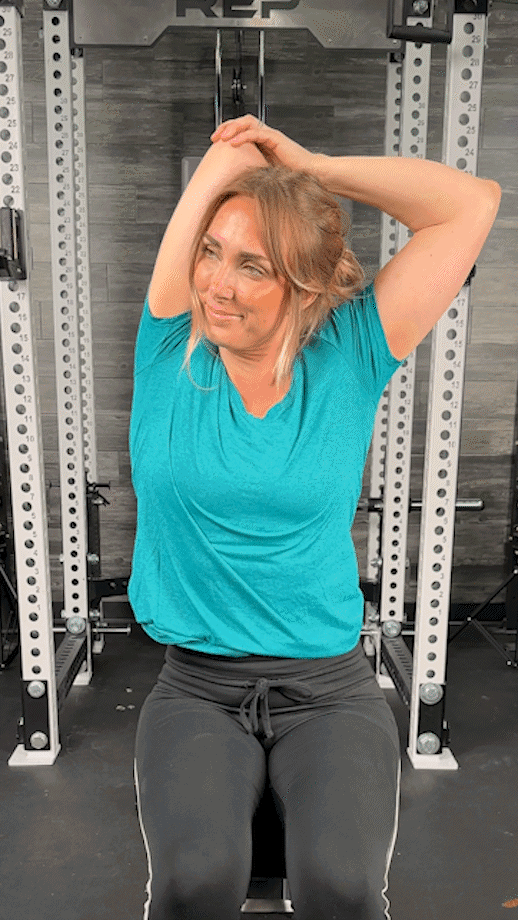
Forearm Wrist Stretch
Why we love it: “Working on a computer can cause stiffness and pain in the wrist and forearm,” says Kate. “The forearm wrist stretch lengthens these muscles to alleviate pain and help you get through the work day pain-free.”
How to do it:
- Hold your left arm in front of your body with the palm facing up and the elbow bent.
- Reach over with your right hand to grab your left fingers.
- Gently pull the fingers back as you straighten your left elbow. You should feel the stretch in your wrist, forearm, and elbow.
- Hold briefly, then release and repeat for your right side.
RELATED: Forearm Workouts
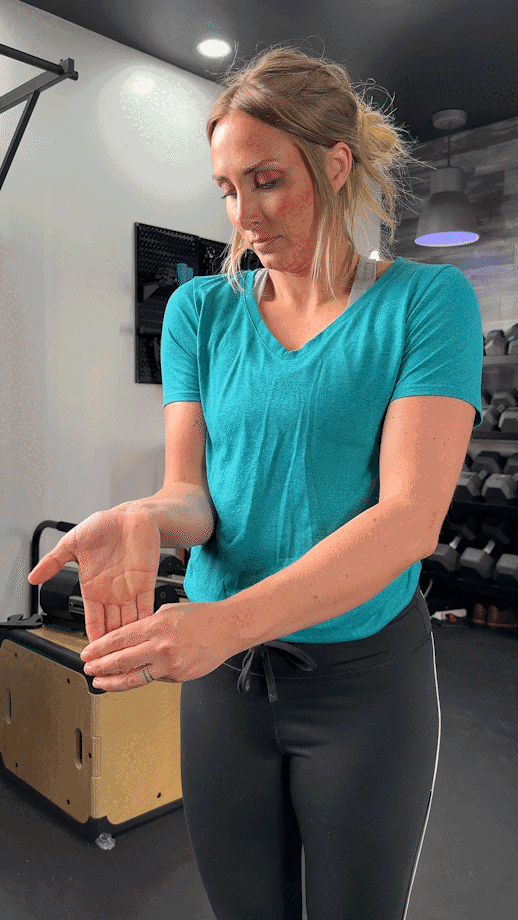
Neck Circles
Why we love it: Occupational and Environmental Medicine studies show5 that sedentary jobs contribute to neck pain, especially if you’re tucking your chin (neck flexion) excessively. Neck circles allow your neck muscles to experience a full range of motion to loosen up and stave off the negative effects of excessive neck flexion.
How to do it:
- Start with your head straight, neck neutral, and eyes forward.
- Tuck your chin to your chest, then slowly roll it towards the right shoulder.
- Pause once you feel a good stretch, then continue rolling your neck to point your chin to the ceiling. Stay here for a few seconds as well.
- Roll your neck up and over all the way to the left shoulder, pausing here, then returning to center when you’re finished.
- Repeat the movement, now rolling in the other direction.
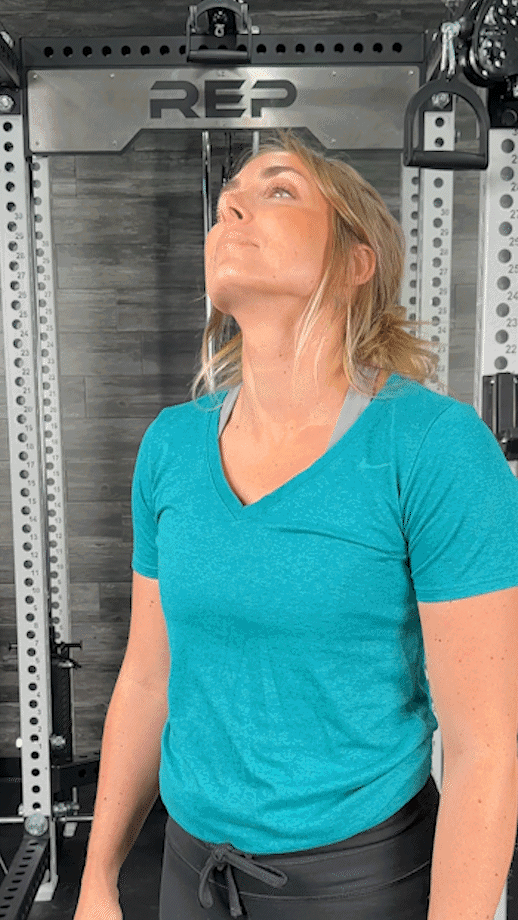
Chest Stretch
Why we love it: Sitting for long periods effectively obliterates your posture, but back pain and weight gain aren’t the only negative effects. The Journal of Physical Therapy Science6 found that poor posture caused by a sedentary lifestyle can reduce respiratory function, too. The chest stretch helps combat these ill effects.
How to do it:
- Clasp your hands together behind your back.
- Keeping your elbows straight, bring your arms up behind your back.
- Continue until you feel your chest stretch and open up.
- Hold for the desired duration, then release.
- Alternatively, you can perform the chest stretch seated by clasping your hands together behind your back and leaning forward into a fold.
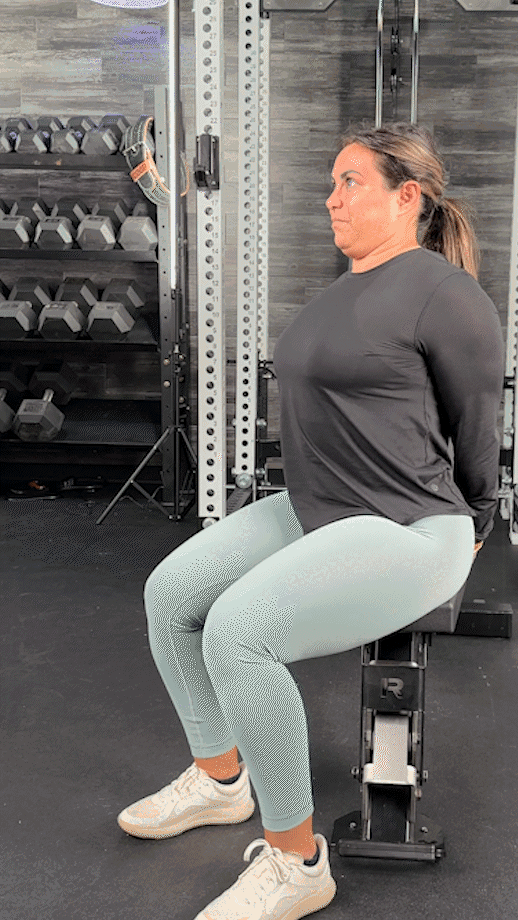
Seated Spinal Twist
Why we love it: “Sitting in the same position for many hours creates stiffness throughout the whole body, but many people feel it specifically in their core, trunk, and lower backs,” says Kate. “Seated spinal twists use rotation to loosen these muscles and provide some pain relief, too.”
How to do it:
- Sit upright in a chair, keeping both feet planted on the floor.
- Grab hold of your armrest or the seatback, if your flexibility allows, and twist. Your back may crack, and that’s okay, but do not force it to crack.
- Continue until you feel a good stretch, then hold the position.
- Return to center, then repeat for the other side.
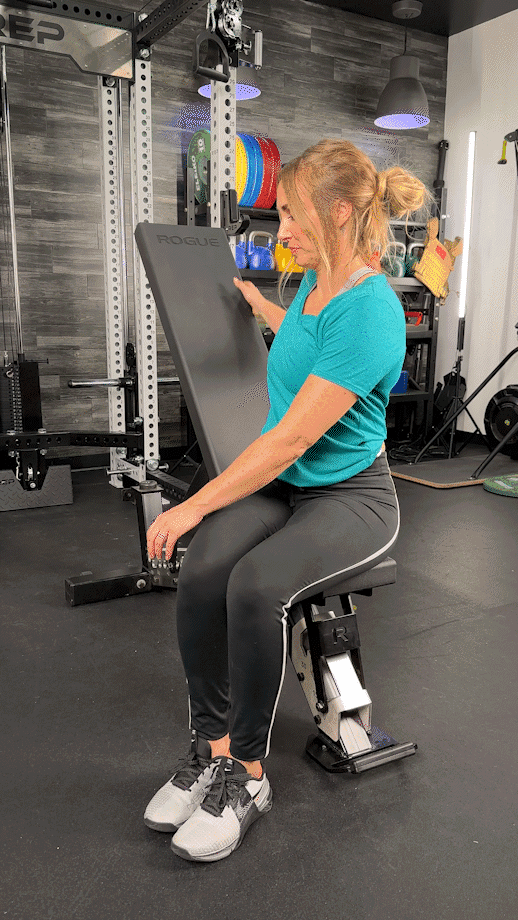
Forward Fold
Why we love it: The forward fold feels divine when you’ve spent most of the day slumped over in an office chair. The positioning relieves tension in the neck and back, improving flexibility and providing some mild pain relief.
How to do it:
- Stand with your feet hip-width apart, knees slightly bent, and arms at your sides.
- Inhale, then breath out and fold forward from the hips.
- Continue until you’re touching or nearly touching the floor.
- Hold the position for a few seconds, then reverse the movement to stand back up.
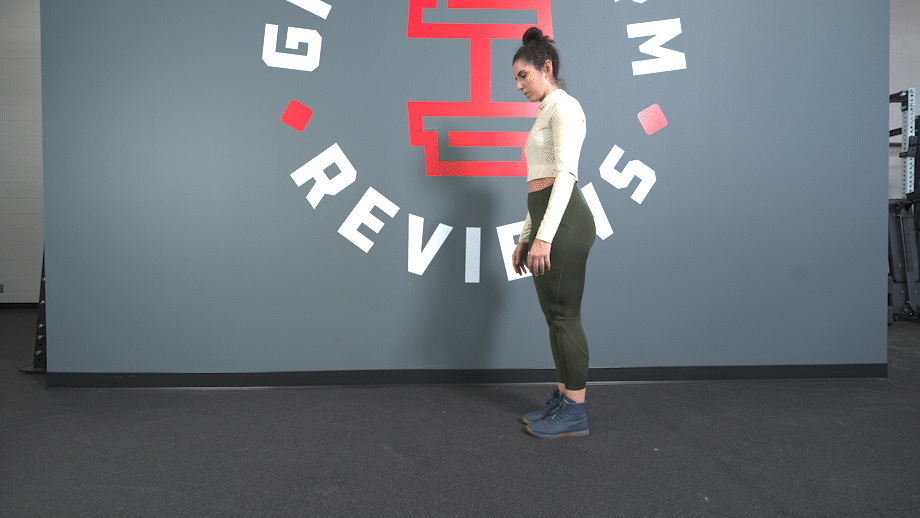
Office Workout Benefits
Desk jobs don’t always require you to get up and move often, but there are many benefits associated with getting up, standing, walking, and performing a few exercises and stretches while at your workplace.
According to Applied Physiology, Nutrition, and Metabolism2, “reducing or breaking up sedentary behaviour may benefit body composition and markers of cardiometabolic risk,” helping stave off the health risks associated with prolonged sitting, including obesity and cardiovascular disease.
According to Pain Management Nursing7, stretching regularly contributes to reduced low back pain, which could be beneficial for nurses and other professionals who experience work-related pain like back pain, neck pain, stiffness, and more.
“There’s a lot of evidence stating the benefits of regular exercise, but getting in a light workout while at work helps contribute to better health and wellness while reducing the risks associated with prolonged sitting” says Kate Meier, CPT, USAW-L1, CF-L1, and GGR Head of Content.
How to Move More Throughout the Work Day
A light, full-body office workout will work wonders for your health, but it’s not for everyone.
Here are a few quick tips to help you get up and move more throughout the day because, as they say, doing something is always better than doing nothing:
- Schedule movement breaks: The workday often boils down to having to do certain things at certain times. Make a 5-minute appointment with yourself at the top or end of each hour, where you’ll commit to taking a quick stroll, stretching, or doing an exercise.
- Go outside for lunch: Workaholics love having lunch at their desk, but you’re still stuck sitting if you do that. Go out for a healthy lunch or use your lunch break to find a nice spot outside where you can eat peacefully then take a quick stroll.
- Grab a drink: Some offices provide a water cooler or coffee pot for employee use. Refill your water bottle or mug regularly to both stay hydrated and have an excuse to move.
- Take the stairs: If your office is above the ground floor, taking the stairs instead of the elevator is a good choice. Additionally, a 2019 study shows8 that ascending a few staircases, even if for short durations, may modestly improve cardio fitness.
- Invest in a standing desk: There are many desks available that convert from a standard desk to a standing desk with a few minor adjustments. Spending part of your work day in a standing position should reduce adverse effects associated with sitting.
- Invest in an under-desk treadmill: There are also many low profile under-desk treadmills that let you get in your steps while you make that crucial sales call. You don’t have to get in a full-on HIIT session, but walking will definitely help the cause.
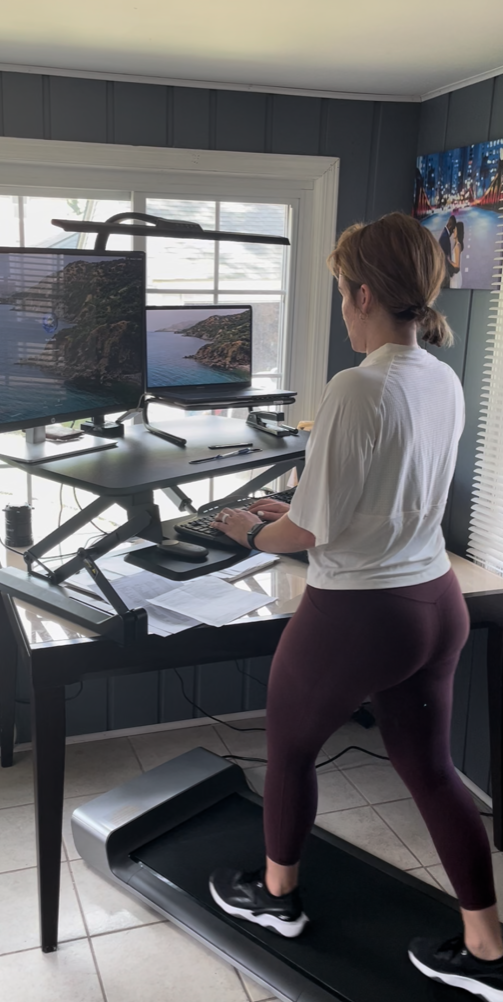
RELATED: 8 Time-Saving HIIT Cardio Workouts At Home
Sample Office Workout
| Exercise | Sets | Reps / Duration |
| Jumping Jacks | 2 to 3 | 10 to 20 |
| Side Lunges | 2 to 3 | 10 to 20 |
| Desk Push-Ups | 2 to 3 | 5 to 10 |
| Triceps Stretches | 2 to 3 | 30 seconds |
| Chair Squats | 2 to 3 | 5 to 10 |
| Chair Dips | 2 to 3 | 5 to 10 |
| Forward Folds | 2 to 3 | 30 seconds |
| Wall Sits | 2 to 3 | 30 seconds |
“There are many ways to tackle this workout,” says Kate Meier, CPT, USAW-L1, CF-L1. “If you have time during the day, maybe on your lunch break, when you can do a light 30-minute workout, you can get it done in one shot. Otherwise, working in one set of an exercise during little breaks, like between emails, phone calls, meetings, etc., works just as well and you can keep chipping away until you get to everything.”
Office Workout: Final Thoughts
Sitting in an office all day feels mentally taxing, but it also takes a great physical toll on your body and could increase your risk for many adverse health conditions.
It may attract some weird looks from your co-workers, but getting in an office workout should help reduce those risks and contribute to better all-around health and fitness.
Try some of our “deskercises” during your next work day!
Office Workout: FAQs
How can I exercise while working in an office?
There are many bodyweight movements that can be performed just about anywhere, but keeping a few fitness essentials like a light dumbbell and an exercise mat in your office or work bag enables you to do many exercises right there at your desk.
RELATED: Best Exercise Mats
How do I stay in shape while sitting at my desk all day?
“Hitting the gym before or after work helps you stay in shape, even if you’re sitting down all day,” says Kate Meier, CPT, USAW-L1, CF-L1, and GGR Head of Content. “The best way, however, is to work out and move while at work. It doesn’t have to be an official workout, but moving frequently while at work helps support your overall success.”
How can I be less sedentary at work?
Head to the water cooler, take the stairs, stand up and pace while taking phone calls, walk to your friend’s cubicle for a quick chat instead of just sending a text or email—there are loads of ways to reduce the time you spend sitting. Don’t be afraid to get creative!
References
1. Sitting and standing. U.S. Bureau of Labor Statistics. Accessed October 19, 2023. https://www.bls.gov/ors/factsheet/sit-and-stand.htm.
2. Saunders TJ, McIsaac T, Douillette K, et al. Sedentary behaviour and health in adults: an overview of systematic reviews. Appl Physiol Nutr Metab. 2020;45(10 (Suppl. 2)):S197-S217. doi:10.1139/apnm-2020-0272
3. Matthews CE, Carlson SA, Saint-Maurice PF, et al. Sedentary Behavior in U.S. Adults: Fall 2019. Med Sci Sports Exerc. 2021;53(12):2512-2519. doi:10.1249/MSS.0000000000002751
4. Chang WD, Lin HY, Lai PT. Core strength training for patients with chronic low back pain. J Phys Ther Sci. 2015;27(3):619-622. doi:10.1589/jpts.27.619
5. Ariëns GA, Bongers PM, Douwes M, et al. Are neck flexion, neck rotation, and sitting at work risk factors for neck pain? Results of a prospective cohort study. Occup Environ Med. 2001;58(3):200-207. doi:10.1136/oem.58.3.200
6. Kang KW, Jung SI, Lee do Y, Kim K, Lee NK. Effect of sitting posture on respiratory function while using a smartphone. J Phys Ther Sci. 2016;28(5):1496-1498. doi:10.1589/jpts.28.1496
7. Chen HM, Wang HH, Chen CH, Hu HM. Effectiveness of a stretching exercise program on low back pain and exercise self-efficacy among nurses in Taiwan: a randomized clinical trial. Pain Manag Nurs. 2014;15(1):283-291. doi:10.1016/j.pmn.2012.10.003
8. Jenkins EM, Nairn LN, Skelly LE, Little JP, Gibala MJ. Do stair climbing exercise “snacks” improve cardiorespiratory fitness?. Appl Physiol Nutr Metab. 2019;44(6):681-684. doi:10.1139/apnm-2018-0675
Further reading

Looking to take your core workouts to the next level? Check out our picks for the best core exercise equipment for 2023. Read more

Looking for a new yoga app? In this Alo Moves review, we’ll break down everything you need to know about this popular workout app. Read more

Our experts provide four jump rope exercises to work into your fitness regimen. Read more

Our FightCamp review looks at this kickboxing-inspired smart home gym system that’s fun and engaging for people of all fitness levels. Read more

